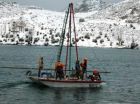(Press-News.org) A team of Spanish researchers have used different geological samples, extracted from the Enol lake in Asturias, to show that the Holocene, a period that started 11,600 years ago, did not have a climate as stable as was believed.
The Holocene period, which includes the last 11,600 years of our history, has always been described as a stable period in terms of climatic conditions, especially when compared to the abrupt changes that occurred in the last ice age, which ended around 10,000 years ago, giving way to the Holocene.
A study carried out by researchers from the Pyrenean Institute of Ecology (IPE) at the Spanish Research Scientific Council (CSIC), in collaboration with other scientists from Zaragoza, La Coruña, Valencia and Cádiz universities, and published in the Journal of Paleolimnology, has found climatic differences amongst the "stable" 13,500 years.
The study specifically focused on the Enol lake (Asturias), where various sediment samples were extracted from the bottom. These samples provide data about the regional humidity and temperature changes in the area over more than 135 centuries.
The project, together with a previous study that details the last ice age and another, more recent one that examines the last centuries, implies "the first time glacial evolution and climate change have been registered in the last 40,000 years in the Picos de Europa National Park" claims Ana Moreno, researcher from the IPE-CSIC and lead author of the study.
The Enol lake was formed 40,000 years ago following the retreat of a glacier which dug a trough, allowing the accumulation of sediments and water. 18,000 years ago it was already a lake and organic sediments that are currently being studied were starting to be deposited.
From the lake sediments the physical properties and the amounts of organic carbon, carbonate and other elements, could be analysed, as well as some biological indicators, such as diatom and ostracod fossils.
Vegetation cover evolution
Furthermore, the detailed study of pollen accumulated in this material allows us to make a reconstruction of the variations of vegetation cover, which is crucial information in the context of climate change and the impact of human beings.
The researchers recognised at least 4 different stages in the Holocene: the first one was cold and dry, between 13,500 to 11,600 years ago (cal years BP) which included a brief return to the icy condition known as Younger Dryas. This was followed by a period of higher temperature and humidity, between 11,600 and 8,700 years ago, which coincided with the beginning of the Holocene.
The third period had a drier climate, between 8,700 and 4,650 years ago, and finally a return to the more humid climate from then up to 2,220 years ago. The study also highlights the changes caused in the latest period caused by human activity, specifically from pasture and deforestation.
The study's conclusions therefore report significant environmental changes throughout the last 13,500 years in history. They also show how at the beginning of the Holocene, the vegetation coverage of the area, which until that time had consisted of Pinus (pine), Betula (birch) and Quercus (oak), then became a forest of mainly Quercus.
Researchers also highlight an increase in precipitation for nearly twelve centuries (between 9,750 and 8,600 years ago), which led to an increase in Corylus, or in other words, Hazel. Although the study of these geological traces from the Enol lake only covers up to 2,200 years ago, it is possible to determine the environmental impact that the region's inhabitants of that time had from studying the pollen.
Former use of mountain pastures
Moreno said that "The use of mountain pastures is possibly the oldest documented human activity in the area. As we have seen, the lengthy sampling of Lago Enol detected that an opening in the landscape began 4,650 years ago, and most notably from 2,700 years ago".
The results also show that from 4,650 years ago, humans contributed a greater presence of herbaceous species (from the Plantago and Rumex Acetosella genera) and a decrease in the area's woodlands.
Those in charge of the study claim that these hydrological and landscape stages from the Enol lake sediments demonstrate the biggest changes in the climate registered during the Holocene in the south of Europe. The Cantabria mountains were like that 2,200 years ago, a date that coincided with the Roman occupation and the start of the Second Punic Wars against the Carthaginians led by Hannibal.
In a more recent study, these researchers found from the pollen register that there have been many alterations in the landscape, which were caused by human activity in the last 200 years. For example, they detected a change in the number of coprophilious fungi (which feed on the faeces of the livestock that graze there) throughout the twentieth century.
According to the researchers, this is due to the fact that "the indigenous bovine livestock were replaced by Alpine Brown cattle, and, before that, high-milk yielding Frisians. This way it changes from being an extensive livestock on the mountain, with the indigenous cattle, to another intensive type, with stables at the bottom of the valley. Another change that the pollen shows is the introduction of eucalyptus plants in 1930.
INFORMATION:
References:
Moreno, A., López-Merino, L., Leira, M., Marco-Barba, J., González-Sampériz, P., Valero-Garcés, B., López-Sáez, J. A., Santos, L., Mata, P., Ito, E.. "Revealing the last 13,500 years of environmental history from the multiproxy record of a mountain lake (Lago Enol, northern Iberian Peninsula)". Journal of Paleolimnology 46 (3): 327-349, 2011. DOI 10.1007/s10933-009-9387-7.
Lourdes López-Merino, Ana Moreno, Manel Leira, Javier Sigró, Penélope González-Sampériz, Blas L. Valero-Garcés, José Antonio López-Sáez "Two hundred years of environmental change in Picos de Europa National Park inferred from sediments of Lago Enol, northern Iberia" Journal of Paleolimnology 46 (3): 453-467, 2011. DOI: 10.1007/s10933-011-9546-5.
Sediments from the Enol lake reveal more than 13,500 years of environmental history
2012-02-06
ELSE PRESS RELEASES FROM THIS DATE:
Jointly utilizing LTE networks
2012-02-06
Smartphones and tablets are some of the big sellers of the past year. Mobile Internet usage has increased rapidly with the sales success: according to a study of the industry association VATM, in 2011 the average data volume per mobile Internet user increased by 82 percent in Germany. In contrast to its predecessor UMTS, with the new LTE mobile radio standard, the clearly higher data rates and the shorter signal transmission times, providers want to cover the expected traffic. That is why the expansion of the LTE network is being pursued aggressively. Providers are setting ...
Making sense of addiction terminology
2012-02-06
London, UK – A new editorial released this week offers clarity and structure on confusing drug and alcohol addiction terminology for prescribers, users and regulators. "Through a glass darkly: can we improve clarity about mechanism and aims of medications in drug and alcohol treatments?" is published in the Journal of Psychopharmacology, the official journal of the British Association for Psychopharmacology, published by SAGE.
David Nutt and Anne Lingford-Hughes of Imperial College London's Neuropsychopharmacology Unit together with Jonathan Chick from Queen Margaret ...
Collective action
2012-02-06
If you wanted to draw your family tree, you could start by searching for people who share your surname. Cells, of course, don't have surnames, but scientists at the European Molecular Biology Laboratory (EMBL) in Heidelberg, Germany, have found that genetic switches called enhancers, and the molecules that activate those switches – transcription factors – can be used in a similar way, as clues to a cell's developmental history. The study, published today in Cell, also unveils a new model for how enhancers function.
Looking at fruit fly embryos, Guillaume Junion and Mikhail ...
Judder-free videos on the smartphone
2012-02-06
The journey for the family holiday can be a long one. To avoid the incessant "Are we there yet?", stressed parents gladly hand their smartphones to the back seat – so the kids can watch videos or movies on the internet. While modern technology provides for entertainment, it occasionally reaches its limits and then the whining returns: The movies sometimes judder, or are completely interrupted. The cause may be twofold: If the user is standing at the basin of a valley and has poor reception, the data stream transmission rate is inadequate and the cellphone cannot download ...
Surface of Mars an unlikely place for life after 600 million year drought, say scientists
2012-02-06
Mars may have been arid for more than 600 million years, making it too hostile for any life to survive on the planet's surface, according to researchers who have been carrying out the painstaking task of analysing individual particles of Martian soil. Dr Tom Pike, from Imperial College London, will discuss the team's analysis at a European Space Agency (ESA) meeting on 7 February 2012.
The researchers have spent three years analysing data on Martian soil that was collected during the 2008 NASA Phoenix mission to Mars. Phoenix touched down in the northern arctic region ...
Global extinction: Gradual doom is just as bad as abrupt
2012-02-06
A painstakingly detailed investigation shows that mass extinctions need not be sudden events. The deadliest mass extinction of all took a long time to kill 90 percent of Earth's marine life, and it killed in stages, according to a newly published report.
Thomas J. Algeo, professor of geology at the University of Cincinnati, worked with 13 co-authors to produce a high-resolution look at the geology of a Permian-Triassic boundary section on Ellesmere Island in the Canadian Arctic. Their analysis, published Feb. 3 in the Geological Society of America Bulletin, provides strong ...
Soy isoflavone supplements did not provide breast cancer protections
2012-02-06
PHILADELPHIA -- Soy isoflavone supplements did not decrease breast cancer cell proliferation in a randomized clinical trial, according to a study published in Cancer Prevention Research, a journal of the American Association for Cancer Research.
Lead researcher Seema A. Khan, M.D., professor of surgery at the Robert H. Lurie Comprehensive Cancer Center of Northwestern University, said the results of this study are consistent with the findings of previous studies that were designed to test cancer prevention benefits of dietary supplements.
"Simply put, supplements are ...
Dignity counts when caring for older people
2012-02-06
Older people feel that their health problems pose a challenge to their sense of independence, dignity and identity and sometimes the health care they are given makes things worse.
According to research funded by UK Research Councils' New Dynamics of Ageing programme (NDA), healthcare providers must avoid taking a 'blanket view' of how to help older people cope with the ageing process.
The study carried out by Dr Liz Lloyd and her colleagues found that people were often surprised by the impact that illness and growing old had on their lives. Their sense of 'self' was ...
Lower levels of sunlight link to allergy and eczema
2012-02-06
Sunshine may help to prevent allergies and eczema
Increased exposure to sunlight may reduce the risk of both food allergies and eczema in children, according to a new scientific study published this week.
Researchers from the European Centre for Environment & Human Health, along with several Australian institutions, have found that children living in areas with lower levels of sunlight are at greater risk of developing food allergies and the skin condition eczema, compared to those in areas with higher UV.
The research team used data from a study of Australian children ...
Gene related to fat preferences in humans found
2012-02-06
A preference for fatty foods has a genetic basis, according to researchers, who discovered that people with certain forms of the CD36 gene may like high-fat foods more than those who have other forms of this gene.
The results help explain why some people struggle when placed on a low-fat diet and may one day assist people in selecting diets that are easier for them to follow. The results also may help food developers create new low-fat foods that taste better.
"Fat is universally palatable to humans," said Kathleen Keller, assistant professor of nutritional sciences, ...



